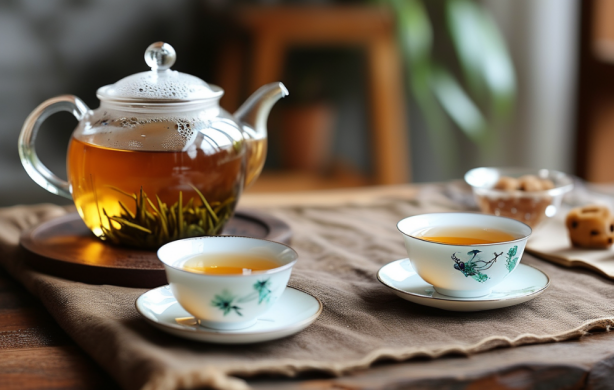
Tea is thought to have started in China and was first written about in Shennong’s Classic of Materia Medica during the Qin and Han dynasties (221 BC-220 AD). Early Chinese people used tea leaves for medicine, then added them to soups or greens, and later drank them as a beverage.
Old books, including Shennong’s Classic of Materia Medica, talked about tea’s health benefits like helping digestion, improving brain and urinary (泌尿的) function, and reducing fatigue. These medical uses of Chinese tea are also known worldwide. For example, Myoan Eisai, a Japanese Buddhist priest from 1141 to 1215, praised tea as a medicine in his book How to Stay Healthy by Drinking Tea. In 2002, Time magazine named China’s green tea one of the top 10 “super healthy” foods.
The Classic of Tea, written by Lu Yu in the Tang Dynasty (618-907), is the first detailed guide on tea and its practices in China, marking the start of Chinese tea culture.
Since the Tang and Song dynasties (960-1279), tea has become very popular, especially among poets like Bai Juyi, Su Shi, Lu You, and Huang Tingjian, who all wrote poems about tea.
For a long time, Chinese people have been growing, picking, making, and drinking tea. Traditional tea processing techniques are mainly found in four major regions in China: north and south of the Yangtze River, southwest China, and south China. There are six main types of tea: green, yellow, dark, white, oolong, and black teas. With reprocessed teas like flower-scented teas, there are over 2,000 varieties in China.
However, social practices related to tea are spread throughout the country and shared by many ethnic groups. As a common saying goes, “firewood, rice, oil, salt, sauce, vinegar, and tea” are the seven daily necessities for every household. In China, drinking tea is an important part of communication and reflects values like modesty, harmony, courtesy (谦恭), and respect.
Tea has also been a way to build peace, friendship, and cooperation between China and the world for many centuries, dating back to when it was a key commodity on the ancient Silk Road and the Tea Horse Road.
原创编写 版权所有 侵权必究! 每日更新 个性化阅读 英语飙升!
1.1.Which of the following is NOT a health benefit of tea according to the text?
A Helping with digestion.
B Improving brain function.
C Dealing with tiredness.
D Improving heart function.
解析:选D。D 细节理解题。根据第二段中的“tea’s health benefits like helping digestion, improving brain and urinary function, and reducing fatigue”可知,饮茶的健康益处包含“帮助消化、改善大脑和泌尿功能、减少疲劳”,并未提及改善心脏功能。故选D。
2.2.What can be inferred about Lu Yu from the passage?
A He was the first person to write about tea in China.
B He praised tea as a medicine in his book.
C He played a key role in the development of Chinese tea culture.
D He was a Buddhist priest who popularized tea in Japan.
解析:选C。C 推理判断题。根据第三段内容可知,唐代陆羽所著的《茶经》是中国第一部详细介绍茶及其实践的书,标志着中国茶文化的开始,即他对中国茶文化具有极其重要的意义。故选C。
3.3.The term “reprocessed teas” refers to teas that are ________.
A treated by special methods again
B one of the most popular teas in China
C made using traditional processing techniques
D grown in specific regions of China
解析:选A。A 词义猜测题。根据“reprocess”的词根process及词缀“-re”可推知,reprocessed teas指的是再加工茶。故选A。
4.4.What is the best title for the text?
A How Chinese Tea Became Popular All Over the World.
B Exploring the Rich Heritage and Wide Reach of Chinese Tea.
C The Medical Benefits of Drinking Chinese Tea.
D The Different Processing Techniques of Chinese Tea.
解析:选B。B 主旨大意题。根据全文内容可知,文章主要介绍了中国茶文化的相关情况,包括茶的起源、功能、相关著作、分类、制茶,以及文化意义等。故选B。
